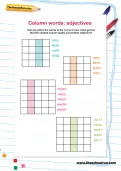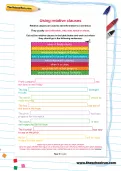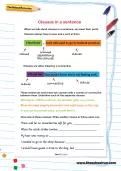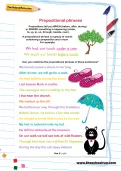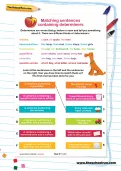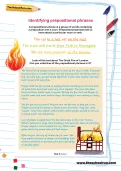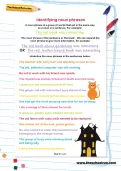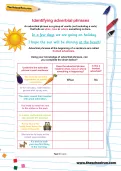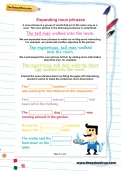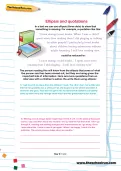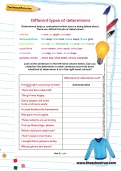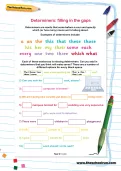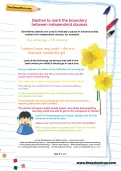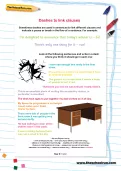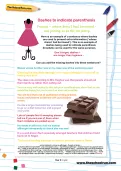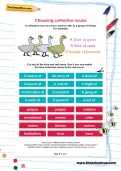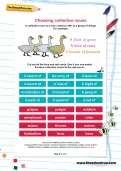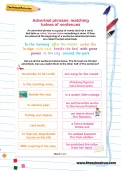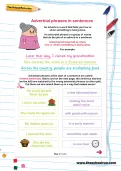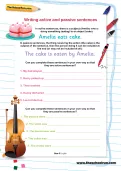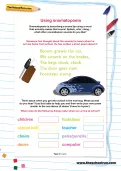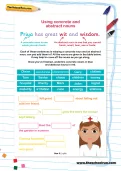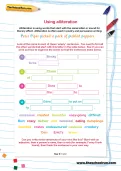Prepositions tell you WHEN (before, after, during) or WHERE something is happening (under, to, up, in, on, through, beside, near). A prepositional phrase is a group of words containing a preposition and a noun. Can you underline the prepositional phrases in these sentences?
or
Register to add to your saved resources
Already a subscriber? to view this content.
Determiners are words that go before a noun and tell you something about it. Look at the sentences on the left and the sentences on the right. Can you draw lines to match them up?
or
Register to add to your saved resources
Already a subscriber? to view this content.
A prepositional phrase is a group of words containing a preposition and a noun. Prepositional phrases tell us more about a particular noun or verb. Look at this text about The Great Fire of London. Can you underline all the prepositional phrases in it?
or
Register to add to your saved resources
Already a subscriber? to view this content.
A noun phrase is a group of words that act in the same way as a noun in a sentence. Underline these noun phrases in the sentences.
or
Register to add to your saved resources
Already a subscriber? to view this content.
An adverbial phrase is a group of words (but no verb) that tells us when, how or where something is done. Using your knowledge of adverbial phrases, can you complete this chart?
or
Register to add to your saved resources
Already a subscriber? to view this content.
A noun phrase is a group of words that act in the same way as a noun. Expand these noun phrases by filling the gaps with interesting, powerful words to make the sentences more descriptive.
or
Register to add to your saved resources
Already a subscriber? to view this content.
In a text we can use ellipsis (three dots) to show that something is missing. Here are some quotations from an interview with a children’s author. Re-write them using ellipsis.
or
Register to add to your saved resources
Already a subscriber? to view this content.
Determiners help us understand which noun is being talked about. There are different kinds of determiner. Look at the sentences in the left-hand column. Can you underline the determiner in each sentence and write down what kind of determiner it is in the right-hand column?
or
Register to add to your saved resources
Already a subscriber? to view this content.
Determiners are words that come before a noun and specify which (or how many) nouns we’re talking about. Each of these sentences is missing determiners. Can you add in determiners that you think will make sense?
or
Register to add to your saved resources
Already a subscriber? to view this content.
Sometimes dashes are used to indicate a pause in sentences that contain two independent clauses. Look at these sentences and add in the dash where you think it should go in each one.
or
Register to add to your saved resources
Already a subscriber? to view this content.
Sometimes dashes are used in sentences to link different clauses and indicate a pause or break in the flow of a sentence. Look at these sentences and write in a dash where you think it should go in each one.
or
Register to add to your saved resources
Already a subscriber? to view this content.
Can you add the missing dashes into these sentences?
or
Register to add to your saved resources
Already a subscriber? to view this content.
Can you match up the collective nouns on the left with the correct nouns on the right?
or
Register to add to your saved resources
Already a subscriber? to view this content.
A collective noun is a noun used to refer to a group of things. Cut out all the blue and red cards. See if you can match the blue collective nouns to the red nouns.
or
Register to add to your saved resources
Already a subscriber? to view this content.
An adverbial phrase is a group of words (without a verb) that tells us when, how or where something is done. If they are placed at the beginning of a sentence adverbial phrases are called fronted adverbials. Cut out all these sentence halves. The first set are fronted adverbials. Can you match them to the other half of the sentence?
or
Register to add to your saved resources
Already a subscriber? to view this content.
Adverbial phrases at the start of a sentence are called fronted adverbials. Cut out these sentence starters and see if you can match them with the correct adverbial phrases.
or
Register to add to your saved resources
Already a subscriber? to view this content.
Can you complete these sentences in your own way so that they are active sentences? Then can you complete these sentences in your own way so that they are passive sentences?
or
Register to add to your saved resources
Already a subscriber? to view this content.
Onomatopoeia is describing a sound by using a word that actually makes that sound. Splash, whir, clang... what other onomatopeic sounds do you like? Think about when you get into school in the morning. What sounds do you hear? Use this table to help you and then write your own poem similar to the one above (it doesn’t have to rhyme!).
or
Register to add to your saved resources
Already a subscriber? to view this content.
Each of these sentences is missing a concrete noun and an abstract noun; can you add them in? Once you’ve finished, underline concrete nouns in blue and abstract nouns in red.
or
Register to add to your saved resources
Already a subscriber? to view this content.
Alliteration is using words that start with the same letter or sound for literary effect. Alliteration is often used in poetry and persuasive writing. Look at the name in each of these ‘empty’ sentences. You need to find all the other words that start with this letter in the table below. See if you can work out how to organise the words so that the sentences make sense.
or
Register to add to your saved resources
Already a subscriber? to view this content.

